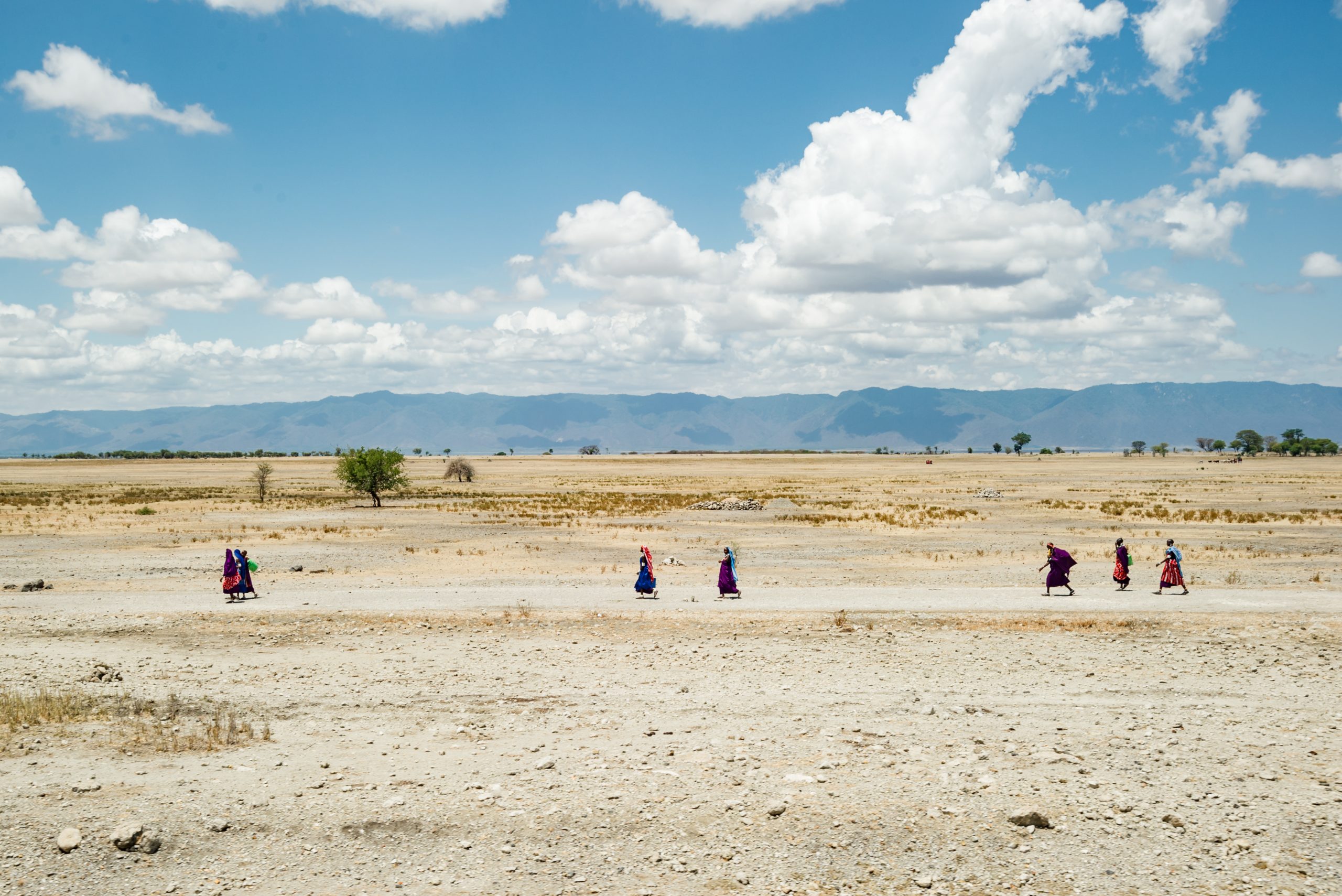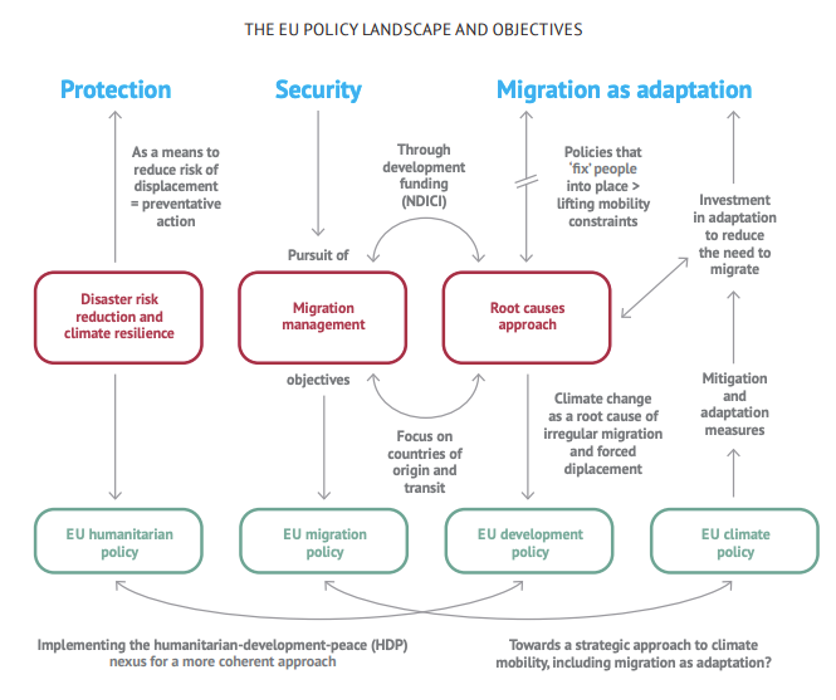
Read more
Blog, Border enforcement, migration controls, and mobility practices
What commercial flight data can tell us about irregular migration
When discussing immigration, we often categorize migrants into two groups: those who follow legal pathways (regular) and those who enter a country through clandestine means (irregular). However, there exists a third, less recognized category...
The EU has been facing one challenge after the next. This age of polycrisis is marked by the complex web of environmental, socio-economic, and security issues. Climate change will not only exacerbate these multidimensional risks but also impact the drivers of migration and mobility.
It is this interplay of factors that demands attention, forward-planning, and coherent policies from the EU. Strategic nexus thinking provides a framework that could help it achieve this.
Based on recent research conducted at the European Policy Centre, we outline how the nexus approach could lead to a less siloed response to climate mobility and the three policy tensions the EU will have to tackle to achieve greater coherence.
Climate mobility and the EU’s polycrisis
Climate change has come to be understood as a ‘risk multiplier’ that heightens the effects of other phenomena including conflict, restricted energy access, loss of livelihoods, and food insecurity. It also has an impact on the drivers of migration and displacement, challenging conventional responses to them. Climate mobility refers to the diverse forms of human movement triggered by environmental changes, primarily those associated with climate change.
Presently, the EU’s approach to climate mobility is split across several policy objectives, leading to short term, siloed responses. The rapid succession of complex crises of the last years, combined with the far-reaching effects of climate change on socioeconomic stability and security have exposed significant policy tensions and put into question the EU’s ability to address them effectively. Its capacity to do so will only be further questioned as the Union reviews its budget and approaches the beginning of a new five-year institutional cycle.
Strategic nexus thinking could provide a way for the EU to respond to future risks more systematically and pre-empt possible crises.
The promise of the nexus approach
The nexus approach has long been a landmark of humanitarian cooperation. Through it, humanitarian, development, and peacebuilding actors have consistently worked along the so-called humanitarian-peace-development (HDP) nexus to:
- overcome deeply ingrained-policy silos;
- identify coherent strategic priorities across different domains; and
- design responses accordingly.
It involves extensive political, institutional, and operational management and coordination (e.g. across UN agencies or European Commission directorates) and requires a clear blueprint of how to align policy objectives.
In the context of climate mobility, the nexus approach could help the EU to have a less fragmented approach and ensure that its climate, development, humanitarian, and migration policies are working towards common goals. We propose that the EU’s climate response must comprise the following policy objectives:
- ensuring access to protection;
- addressing security concerns linked to conflict and instability; and
- supporting migration as a form of adaptation.
However, these objectives, and specifically the policy approaches to achieve them risk being at odds or even undermining each other, and thus standing in the way of better policy coordination. We expand upon the tensions between these three policy approaches below.
Figure 1: Using the nexus approach to develop a more coherent EU response to climate mobility
Key: Blue: policy objective, Red: policy approach, Green: EU policy area.
Source: Hahn & Fessler, The EU’s Approach to Climate Mobility: Which Way Forward?, Brussels: European Policy Centre, 2023.
Three Policy Tensions in the EU’s Approach to Climate Mobility
-
Disaster risk reduction and climate resilience
We found that across the board, the EU’s response is presently most developed in disaster risk reduction and climate resilience. EU humanitarian assistance in this context is not just about the response following natural disasters but is designed as preventative action to reduce the risk of displacement for climate-vulnerable communities.
However, this still leaves open how EU actions can support people displaced as a result of climate change more long-term and how non-forced migration in the context of climate change should be managed.
-
Migration management
Migration management is an area that presents stronger discrepancies between the EU’s longer-term strategic external action priorities, such as promoting human rights and democracy, reducing poverty, and mutually beneficial cooperation, and what often end up being reactive or short-term responses to migratory trends.
As part of its external action, the EU has worked to strengthen nexus thinking around climate and security, which takes into consideration the impacts and reinforcing effect of both climate change and environmental degradation, and as such places particular emphasis on issues like food insecurity, water scarcity, and soil degradation, all of which impact people’s livelihoods.
While this suggests greater ambitions to understand the linkages between different challenges, past years have also seen a resurgence of the securitisation of migration under the guise of migration management, possibly undermining what the EU sets out to do in other areas of its external action. Moreover, this security and control-oriented lens invites future scenarios of “mass climate migration”, leading to a simplistic view of the interaction between mobility and the impacts of climate change.
Between the EU’s protection and security objectives, there is therefore an unresolved trade-off between avoiding and mitigating climate risks, including the risk of displacement, and reducing the overall amount of (cross-border) migration, which is linked rather to instability or conflict than climate change per se.
Domestically, at a time when the EU is urgently trying to find ways to address labour shortages, the overclouding of migration management objectives could undermine other such important socio-economic imperatives.
-
Root causes approach
The impact of the migration management logic must also be viewed in light of the persistent trend of governing migration through development funds.
With a budget several times higher than humanitarian assistance, EU development policy currently constitutes the main avenue through which the EU is addressing climate mobility (factoring in climate mainstreaming). But whereas there is clarity on how EU humanitarian assistance benefits people affected by climate change, it is less straightforward for the use of development funding.
This is largely due to the dominance of the “root causes” framing, which seemingly sees all migration, not just irregular migration, as a problem and seeks to reduce it by addressing its underlying causes (e.g. reducing poverty or improving infrastructure will reduce migration).
But this view risks overlooking the fact that some people may choose to move over in-situ adaptation to a changing climate. Provided the right conditions are in place and support is available, migration can thus be a pre-emptive or positive response to the worsening effects of climate change. While migration as adaptation has been subject to countless studies, and while acknowledging its importance, the EU has thus far failed to seriously grapple with the implications of migration as a form of adaptation for its development and migration cooperation.
This can be attributed to the EU’s persistent focus on strengthening border management in non-EU countries for migration management purposes, which can conflict with domestic policy goals, like expanding free movement. But it is also linked to a sedentary bias held by many policymakers in the Global North, which assumes people prefer to stay where they are, even in the face of slow-onset environmental degradation. While important to prevent forced migration, this bias precludes recognition and broader consideration of climate mobilities, including legal migration pathways.
In this context, efforts to improve climate resilience, including infrastructure investments or technical assistance, are important and needed but still only cover a portion of the climate action portfolio and do not necessarily factor in mobilities. Unsurprisingly, for example, international mobility pathways to support the green transition remain underexplored in the EU.
A credible and coherent response to climate mobility
Going forward, the EU must resolve these policy tensions to achieve a more coordinated and coherent response to climate mobility. Strategic nexus thinking that has been employed successfully among humanitarian, peace, and development actors could help the EU to:
- reduce gaps between humanitarian and development aid in the context of climate mobility, by, for instance, reducing the risk of repeat displacement due to lack of longer-term assistance, something that is especially challenging in fragile contexts;
- temper the EU’s migration management objectives with policy priorities in other areas, especially development goals, opening up opportunities for migration and development cooperation that is both reflective of climate mobilities and is more aligned with EU and partners’ priorities;
- recognise and integrate migration as adaptation as one of several potential responses to climate change, and flesh out how it translates into EU policy and programmes.
While migration as adaptation is not a one-size-fits-all solution, it represents a missing piece in the EU’s approach. Viewed through a different lens, migration as adaptation actually reinforces the imperative for the EU to double down on its commitment to expand legal pathways and invest in durable solutions. At a time when discussions on legal migration are gaining headwind, this is an opportunity the EU should not miss.
—-
Helena Hahn is a Policy Analyst at the European Policy Centre in Brussels, where she focuses on EU migration and development cooperation, climate mobility, EU funding, and borders and technology.
Eleonora Milazzo is a Joint Research Fellow at the European Policy Centre and the Egmont Institute in Brussels. Her current work focuses on the policy nexus between migration, climate change, and security.


